The Best Home Remedies for Premenstrual Syndrome (PMS)
Note: Friends, if you are comfortable in reading this article in any other language, please change the language from the translate button on the top of this article.
 |
PMS usually occurs a week or two before the period and
ends when the period starts |
Image: Freepik
Overview
Premenstrual syndrome (PMS) is a group of physical and emotional symptoms that occur in the days leading up to a woman's menstrual period.
PMS usually occurs a week or two before the period and ends when the period starts.
Symptoms of PMS
The symptoms of Premenstrual Syndrome can include cramps, bloating, fatigue, mood swings, and acne.
While these symptoms can be uncomfortable and disruptive, there are a number of home remedies that can help alleviate them.
PMS can be managed with lifestyle changes, such as exercise and stress management, and over-the-counter medications.
In some cases, prescription medications may be necessary to manage severe symptoms.
Exercises such as aerobic exercise, yoga, and strength training can help alleviate symptoms of PMS. Aerobic exercise, such as running or cycling, can help reduce cramps and bloating.
Yoga can help with stress and tension, and certain poses can also alleviate cramps. Strength training can help improve mood and reduce fatigue.
6 Best Yoga Poses For Relief From PMS:
There are several yoga poses that can help alleviate the physical symptoms of PMS such as cramps and menstrual pain.
1. Child's Pose (Balasana):
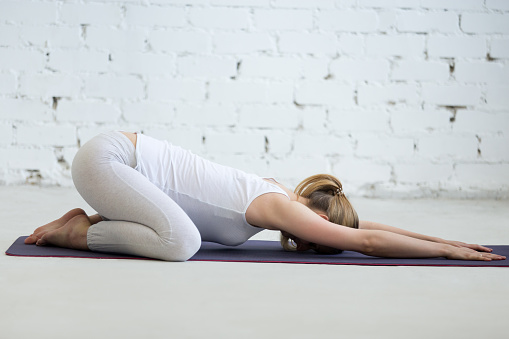 |
| Child's pose helps to relax the lower back and alleviate cramps |
Image: Unsplash
This pose helps to relax the lower back and alleviate cramps. Sit on your heels with your knees hip-width apart, and then lean forward to rest your forehead on the floor. See image above.
2. Cat-Cow Pose (Marjaryasana-Bitilasana):
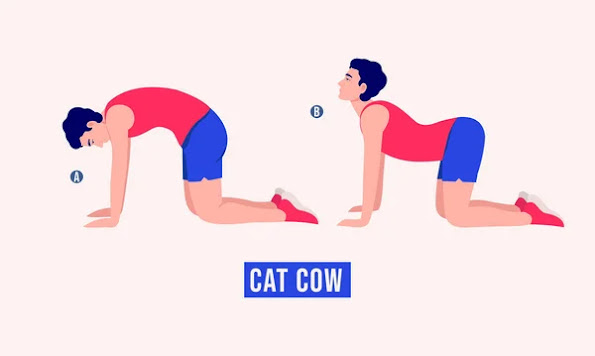 |
| Cat-cow pose helps to stretch the lower back and relieve cramps |
Image: Depositphotos
This pose helps to stretch the lower back and relieve cramps. Begin on all fours, with your wrists under your shoulders and your knees under your hips.
As you inhale, arch your back and lift your head and tailbone; as you exhale, round your spine and tuck your chin to your chest. See the image above.
3. Cobra Pose (Bhujangasana):
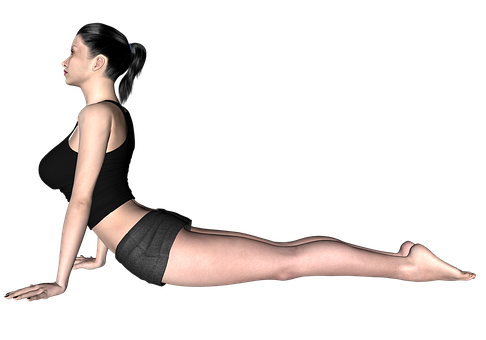 |
| Cobra pose helps to strengthen the lower back and alleviate cramps |
Image: Pixabay
This pose helps to strengthen the lower back and alleviate cramps. Lie on your stomach and place your hands under your shoulders.
As you inhale, press into your hands to lift your chest off the floor. See the image above.
4. Seated Forward Bend pose (Paschimottanasana):
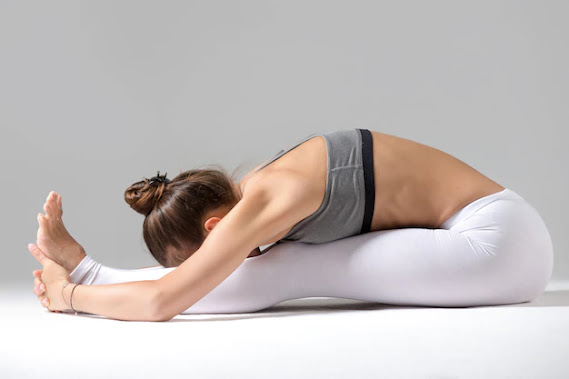 |
The seated forward bend pose helps to stretch the lower back
and alleviate cramps |
Image: Freepik
This pose helps to stretch the lower back and alleviate cramps. Sit on the floor with your legs stretched out in front of you.
As you inhale, lift your arms above your head; as you exhale, bend forward from the hips to reach your toes. See the image above.
5. Pigeon Pose (Eka Pada Rajakapotasana):
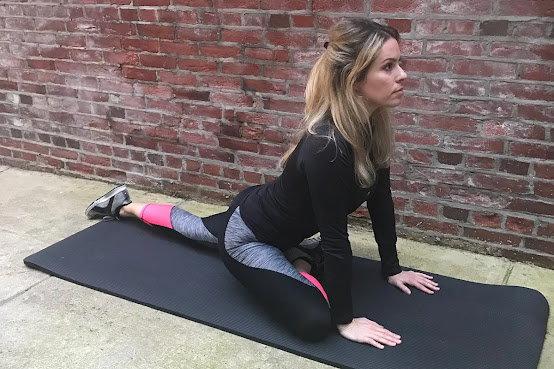 |
| The pigeon pose helps to stretch the hips and alleviate cramps |
Image: The Philadelphia Inquirer
This pose helps to stretch the hips and alleviate cramps. Start in a plank position, and then bring your right knee to your right hand and slide your right foot to the left of your left hand.
Lower your hips to the floor and extend your left leg behind you. See the image above.
6. Downward-Facing Dog pose (Adho Mukha Svanasana):
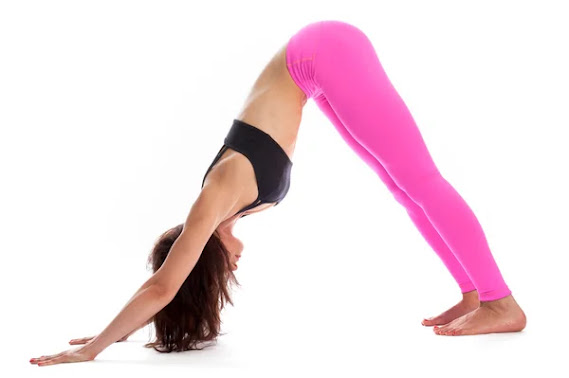 |
The downward-facing dog pose helps to stretch the lower
back and alleviate cramps |
Image; Depositphotos
This pose helps to stretch the lower back and alleviate cramps. Start on all fours, and then lift your hips up and back to create an inverted "V" shape with your body.
* It's important to note that everyone's body is different, and some poses may be more comfortable for some individuals than others.
Effective Acupressure Therapy For Relief From PMS, That You Can Do At Your Home:
Please see the above video for reference.
- Use a stretched finger or thumb and apply deep, firm pressure on each acupressure point mentioned here, for 3 minutes.
- Withdraw slowly and repeat 3 times. There is no limit to doing the number of times a day.
- The first point is the Gate Of Origin located 4 finger widths below the Navel. Press for 3 minutes. Repeat 3 times.
- The second point is the Sea Of Energy located 2 finger widths below the Navel. Press for 3 minutes and repeat 3 times. You can take the help of someone.
- The third point is Mansion Cottage. It is a pair of points located on the Pelvic Area, right at the center of the crease where legs join the trunk of the body. Press these 3 times for 3 minutes.
- The fourth point is the Rushing Door. This is also a pair of points located in the Pelvic Area exactly below the Mansion Cottage points. Press these 3 times for 3 minutes.
- The fifth point is the Womb & Vitals. It is a pair of points right outside the Spectrum midway between the Hip Bone and the base of the Buttocks. Press them 5 times for 3 minutes.
- The sixth point is Three Yin Crossing located four finger widths above the Ankle Bone close to the skin bone. Press this 3 times for 3 minutes. Never press these points during the 8th and 9th months of pregnancy.
- The seventh point is the Union Valley located in the fleshy joint between the Thumb and the Index Finger. Press it 3 times for 3 minutes for each hand. Avoid pressing this point during pregnancy.
- Take a cup of hot herbal tea after the session.
- If you can't press all points daily, you can select any 3 points in a day.
Our Other Must-Read Articles:
Some More Tips And Home Remedies For PMS:
Exercise:
Regular exercise can help reduce the severity of PMS symptoms by releasing endorphins, which are natural mood boosters.
Aim for at least 30 minutes of moderate-intensity exercise per day.
Heat therapy:
Applying heat to the lower abdomen can help alleviate cramps and other menstrual pain. Try using a heating pad or taking a warm bath.
Relaxation techniques:
Stress can exacerbate PMS symptoms, so it's important to take steps to manage stress. Relaxation techniques such as yoga, meditation, and deep breathing can help.
Diet:
Eating a healthy diet that is rich in fruits, vegetables, whole grains, and lean protein can help reduce PMS symptoms. Avoiding processed foods and sugar can also help.
Herbs:
Some herbs, such as ginger and turmeric, have anti-inflammatory properties that can help alleviate cramps and other menstrual pain. Try adding them to your meals or drinking ginger tea.
Vitamin B6:
Vitamin B6 has been found to be effective in reducing symptoms of PMS, such as mood swings and breast tenderness.
You can take vitamin B6 supplements or increase your intake of foods rich in B6, such as fish, chicken, and leafy greens.
Magnesium:
Magnesium is an essential mineral that can help reduce symptoms of PMS such as cramps and fatigue.
You can take magnesium supplements or increase your intake of foods rich in magnesium, such as nuts, seeds, and leafy greens.
Omega-3 fatty acids:
Omega-3 fatty acids have been found to be effective in reducing symptoms of PMS such as mood swings, depression, and cramps.
You can take Omega-3 supplements or increase your intake of foods rich in Omega-3s, such as fatty fish, flaxseeds, and chia seeds.
Calcium:
Calcium is essential for healthy bones and can also help reduce symptoms of PMS such as cramps and mood swings.
You can take calcium supplements or increase your intake of foods rich in calcium, such as dairy products, leafy green vegetables, and almonds.
Drink plenty of water:
Staying hydrated is important for overall health, and it can also help alleviate PMS symptoms.
Drinking water can help reduce bloating and water retention, and it can also help flush out toxins from the body.
Get enough sleep:
Lack of sleep can exacerbate PMS symptoms, so it's important to get enough sleep during this time. Aim for at least 7-8 hours of sleep per night.
Avoid caffeine and alcohol:
Caffeine and alcohol can both exacerbate PMS symptoms such as mood swings, anxiety, and depression. Try to limit your intake of these substances during the days leading up to your period.
Acupuncture and Massage:
Acupuncture and massage have been shown to be effective in reducing symptoms of PMS such as cramps, fatigue, and mood swings.
Acupuncture can help to balance hormones and reduce inflammation in the body, while massage can help to relax tense muscles and reduce stress.
If your symptoms are severe or are impacting your daily life, it's a good idea to speak with your healthcare provider.
Some Frequently Asked Questions (FAQs) by people on PMS:
Q. What is PMS?
A. Premenstrual syndrome (PMS) is a group of physical and emotional symptoms that occur in the days leading up to a woman's menstrual period. Symptoms can include cramps, bloating, fatigue, mood swings, and acne.
Q. What is the difference between PMS and Menstrual Cramps?
A. Menstrual Cramps are not the same as Premenstrual Syndrome (PMS). PMS usually occurs a week or two before the period and ends when the period starts.
Menstrual cramps usually start the day a woman's menstrual period starts and may last for the entire period.
Q. What causes PMS?
A. The exact cause of PMS is not known, but it is thought to be related to hormonal changes that occur during the menstrual cycle.
Changes in levels of estrogen and progesterone can affect the levels of other hormones in the body, leading to symptoms of PMS.
Q. What are the symptoms of PMS?
A. Symptoms of PMS can vary from person to person, but common symptoms include cramps, bloating, fatigue, mood swings, and acne. Other symptoms can include headaches, breast tenderness, and food cravings.
Q. How is PMS diagnosed?
A. PMS is typically diagnosed based on a woman's symptoms and the timing of those symptoms in relation to her menstrual cycle.
A healthcare provider may also perform a physical exam and order laboratory tests to rule out other conditions.
Q. How is PMS treated?
A. Treatment for PMS can vary depending on the severity of symptoms. Lifestyle changes such as exercise, stress management, and a healthy diet can help alleviate symptoms.
Very good home remedies like Yoga Poses and Acupressure Therapy is mentioned in this article above.
Over-the-counter pain relievers, such as ibuprofen, can help with cramps and other menstrual pain. In some cases, prescription medications may be necessary to manage severe symptoms.
Q. Can PMS be prevented?
A. There is no way to completely prevent PMS, but lifestyle changes such as regular exercise, stress management, and a healthy diet can help reduce the severity of symptoms.
Q. How does PMS differ from PMDD?
A. Premenstrual dysphoric disorder (PMDD) is a more severe form of PMS. Women with PMDD experience more severe symptoms, such as depression, anxiety, and irritability, that can significantly impact their daily lives.
Stay Fit, Stay Happy
__________________________
Friends, if you liked it, please share it with your friends.
SHARING IS CARING.
Compiled by: Paramjit Singh Rana








Comments
Post a Comment